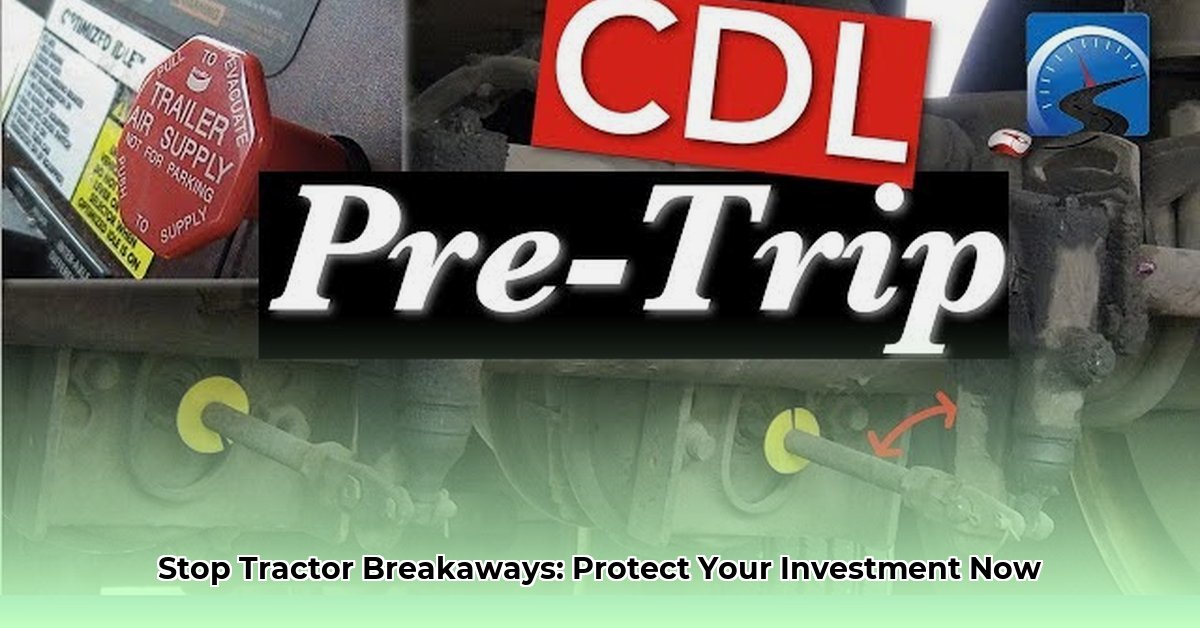
Understanding Tractor Protection Valves (TPVs) and Systems (TPS)
Tractor protection systems (TPS), primarily relying on tractor protection valves (TPVs), are crucial safety mechanisms preventing runaway trailers. A runaway trailer poses significant risks, including property damage, injuries, and fatalities. TPVs automatically engage trailer brakes if the trailer unexpectedly disconnects, preventing a loss of air pressure and maintaining control. How well do you understand your specific TPV's functionality? Are you confident in its ability to protect you and others? For more detailed information on tractor hydraulics, check out this helpful resource.
The Critical Role of TPVs in Preventing Runaway Trailers
A runaway trailer is a serious threat. The force of a detached, uncontrolled trailer can cause devastating consequences. The importance of a functioning TPV cannot be overstated; it's the first line of defense against this dangerous scenario. Regular inspections and maintenance are essential for ensuring your TPV is ready in an emergency.
Regular Inspections: Essential for TPV System Safety
Regular inspections are vital for maintaining the integrity of your tractor protection system. These aren't optional; they are a critical safety measure. Neglecting routine checks puts you, your cargo, and other drivers at considerable risk. Think of it as preventive maintenance for your entire braking system.
Visual Inspection: Carefully examine all components for damage, wear, corrosion, and leaks (especially air leaks). This visual assessment is your first step in ensuring your system's integrity.
Air Pressure Check: Verify adequate air pressure in your tractor's air supply system. Insufficient pressure compromises your TPV's ability to function correctly. Consult your vehicle's manual for the correct pressure specifications.
Functional Test (Breakaway Test): Perform a breakaway test according to the manufacturer's instructions. This test verifies the TPV's responsiveness and ability to engage the trailer's brakes in the event of a disconnection.
Record Keeping: Maintain detailed records of all inspections, documenting findings and any repairs. These records are critical for compliance and troubleshooting.
This four-step process will significantly reduce the risk of TPV failure. A thorough inspection only takes a few minutes but can prevent catastrophic accidents. What steps do you currently take to inspect your TPV system?
Standardized Testing Procedures: A Necessary Improvement
Currently, a lack of standardized testing procedures for TPVs creates inconsistencies and potential safety gaps. Without universal standards, evaluating the reliability of TPVs across different brands and models becomes problematic. "A standardized testing protocol is urgently needed to ensure consistent evaluation and quick identification of system malfunctions," says Dr. Emily Carter, Lead Engineer at the National Transportation Safety Board. This is critical for improving safety across the entire trucking industry.
Driver Training: The Human Element in Road Safety
Even with advanced technology, driver training is essential. Knowing how to react to a trailer breakaway remains crucial, with proper training emphasizing safe responses to this emergency situation. "Driver education isn't just about operating the vehicle; it's about managing potential hazards," states Captain Mark Olsen, Training Director at the Commercial Vehicle Safety Alliance (CVSA). Are your drivers properly trained to handle a runaway trailer scenario?
Collaboration for Safer Roads: A Shared Responsibility
Improving road safety requires collaboration among manufacturers, regulators, and drivers. Manufacturers need to create more reliable TPVs, regulators need to set clearer standards and regulations, and drivers require comprehensive training. We all share a responsibility for creating safer roadways. What proactive steps are you taking to contribute to enhanced road safety?
Emerging Technologies in Tractor Protection Systems
The industry is constantly seeking safer innovations. Self-diagnostic capabilities in TPVs provide real-time monitoring, enhancing safety and reducing accident risks. "The integration of real-time diagnostics is a game-changer for TPV technology," shares John Miller, Chief Technology Officer at Universal Trailer Systems. These advancements show the focus on increasing safety on our roads.
Risk Assessment Matrix for Tractor Protection Systems
| Component | Likelihood of Failure | Severity of Failure | Risk Level | Mitigation Strategies |
|---|---|---|---|---|
| Tractor Protection Valve | Medium | High | High | Regular inspections, prompt replacement when faulty |
| Trailer Braking System | Medium | High | High | Regular maintenance, immediate repair of leaks |
| Tractor Air Supply System | Low | High | Medium | Preventative maintenance, regular pressure checks |
| Driver Response | Medium | High | High | Comprehensive driver training, emergency response drills |
This matrix highlights the critical areas needing attention to mitigate risk effectively. Understanding these potential vulnerabilities is the first step in preventing accidents.
How to Test Heavy-Duty Vehicle Tractor Protection Valves: A Step-by-Step Guide
Testing your TPV is vital for ensuring its effectiveness. This process helps prevent a potentially catastrophic runaway trailer situation. Consistent testing helps discover problems before they cause accidents.
Engage Service Brakes: Fully apply your tractor's service brakes to pressurize the system.
Close Trailer Supply Valve: Close the trailer supply valve completely to isolate the trailer's air brakes.
Disconnect Trailer Service Line: Carefully disconnect the air line connecting the tractor and trailer.
Listen for Air Leaks: Listen carefully for any escaping air. A hiss indicates a faulty TPV and requires immediate attention. No hiss signifies the TPV works.
Remember, variations exist in TPV designs; consult your vehicle's manual for specific instructions. Regular testing, combined with preventative maintenance, is the best way to ensure your TPV system’s reliability.
CVSA Inspection Bulletin 2010-01: Tractor Protection Systems